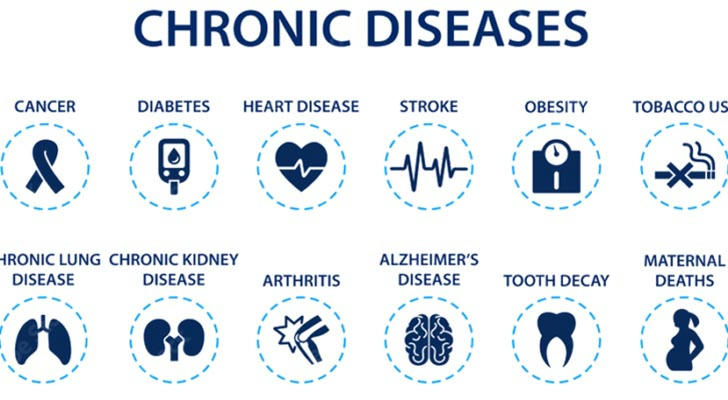Managing Chronic Diseases: Living Well, One Step at a Time
Living with a chronic illness can feel like a never-ending journey of doctor visits, medications, and lifestyle changes. But what if we told you that managing chronic conditions doesn’t always have to feel like a battle? In fact, with the right mindset and a few lifestyle tweaks, living with a chronic illness can become a part of your everyday life, and you can still enjoy many of the things you love. It’s all about managing your condition and embracing a holistic approach to health.
So, let’s dive into the world of chronic disease management and see how you can take control of your health and well-being, without feeling overwhelmed. And don’t worry, we’ll throw in a real-life example to make it all feel a bit more relatable!

1. What Is Chronic Disease, Anyway?
First things first—what exactly is a chronic disease? Simply put, it’s a long-term health condition that lasts for one year or more and requires ongoing medical attention or limits activities of daily living. Common examples include diabetes, heart disease, arthritis, asthma, and even mental health conditions like depression.
The tricky part about chronic diseases is that they often don’t just go away. They require continuous management to keep symptoms in check, avoid complications, and improve quality of life. But here’s the good news: you can manage them effectively with the right tools and strategies.
2. The Role of Lifestyle Changes in Chronic Disease Management
Managing a chronic condition doesn’t mean living in constant restriction or being on a never-ending diet. Instead, it’s about balance. Small lifestyle changes can make a world of difference in how you feel day-to-day. For example, diet, exercise, stress management, and sleep all play huge roles in how your body handles chronic illness.
Diet: Eating a well-balanced, nutrient-rich diet is crucial. For instance, people with diabetes often benefit from a low-glycemic diet to help manage blood sugar levels, while heart disease patients might focus on reducing sodium and eating heart-healthy fats.
Exercise: Regular physical activity—tailored to your condition—can improve mobility, reduce pain, boost mood, and help manage weight. The key here is consistency, not intensity. Think of it as getting your body moving in a way that works for you.
Stress Management: Chronic illness can add mental stress, which, in turn, can exacerbate physical symptoms. Finding ways to manage stress—whether through yoga, meditation, or simply taking a walk outside—can help keep your mind and body in balance.
Sleep: Good sleep hygiene is essential for managing chronic illness. Poor sleep can increase inflammation, make pain worse, and lead to fatigue. So, make sure you’re getting enough rest to recharge your body’s systems.

3. Case Study: Meet Sarah – Managing Chronic Asthma
Let’s meet Sarah, a 34-year-old woman who’s been living with chronic asthma since her teenage years. For years, Sarah felt like asthma was controlling her life. She had regular flare-ups, often finding herself out of breath after even a short walk. She had to carry an inhaler everywhere and struggled with fatigue, especially when her symptoms flared up.
At first, Sarah felt trapped. She thought asthma would always limit her lifestyle. But then, she decided to take a proactive approach to managing her condition. Here’s what she did:
Working with Her Doctor: Sarah’s first step was to work closely with her healthcare provider. They adjusted her medication to ensure she was on the right inhalers and treatments to keep her asthma under control.
Lifestyle Changes: Sarah made subtle but powerful lifestyle changes. She focused on staying active by walking and doing light yoga, which helped her lungs stay strong. She started eating more anti-inflammatory foods like leafy greens, berries, and fish, which helped reduce flare-ups.
Stress Management: Sarah noticed that stress often triggered her asthma. So, she started practicing mindfulness techniques, such as deep breathing and meditation, which helped her manage anxiety and keep her airways relaxed.
Keeping Track: One of the key strategies Sarah used was tracking her symptoms. She kept a journal of when she had flare-ups, what she ate, and how much stress she experienced, so she could identify triggers and avoid them.
Over time, Sarah began to feel more in control of her asthma. She still had flare-ups occasionally, but they were less severe and less frequent. She also found herself more energetic and able to do things she once thought impossible, like hiking and running after her kids.
Sarah’s story is a great reminder that while chronic conditions can’t always be “fixed,” they can be managed effectively with the right approach and support.

4. The Importance of Building a Support System
Managing a chronic disease often means more than just medical treatments—it’s about building a support system. This could include your family, friends, or even support groups for people who understand your struggles. It can also mean finding a professional, such as a therapist or coach, to help you navigate the mental and emotional challenges that come with chronic illness.
When Sarah started her management plan, she reached out to others with asthma for advice and support. She joined an online support group where members shared their experiences, tips, and encouragement. This community helped her feel less isolated and more motivated to stay on track.
Having emotional and social support can make a huge difference in managing your condition. It’s not just about physical health—it’s about feeling mentally supported and empowered.

5. Making It a Lifestyle, Not a Burden
One of the biggest mistakes people make when managing a chronic condition is viewing it as a burden or something to dread. But when you approach chronic disease management as part of your lifestyle, it becomes less overwhelming.
It’s important to embrace the changes, no matter how small, and incorporate them into your daily routine. Over time, these changes will become second nature, and you’ll find that living with a chronic disease isn’t about limitations—it’s about adapting and living life to the fullest.
Start with small steps, and don’t be afraid to ask for help. You don’t have to do this alone, and you don’t have to be perfect. What matters is that you’re taking control, one day at a time.
6. Conclusion: The Path Forward
Managing chronic illness is a long-term commitment, but it doesn’t have to feel like a never-ending struggle. By adopting healthy lifestyle changes, staying on top of your treatment plan, and reaching out for emotional support, you can live a fulfilling and empowered life. Sarah’s journey is just one example, but it shows that with the right tools, mindset, and community, you can take charge of your health.
Remember, it’s not about perfection—it’s about progress. Take each step with confidence, and remember that your chronic condition doesn’t define you. You have the power to live well! 💪🌿
